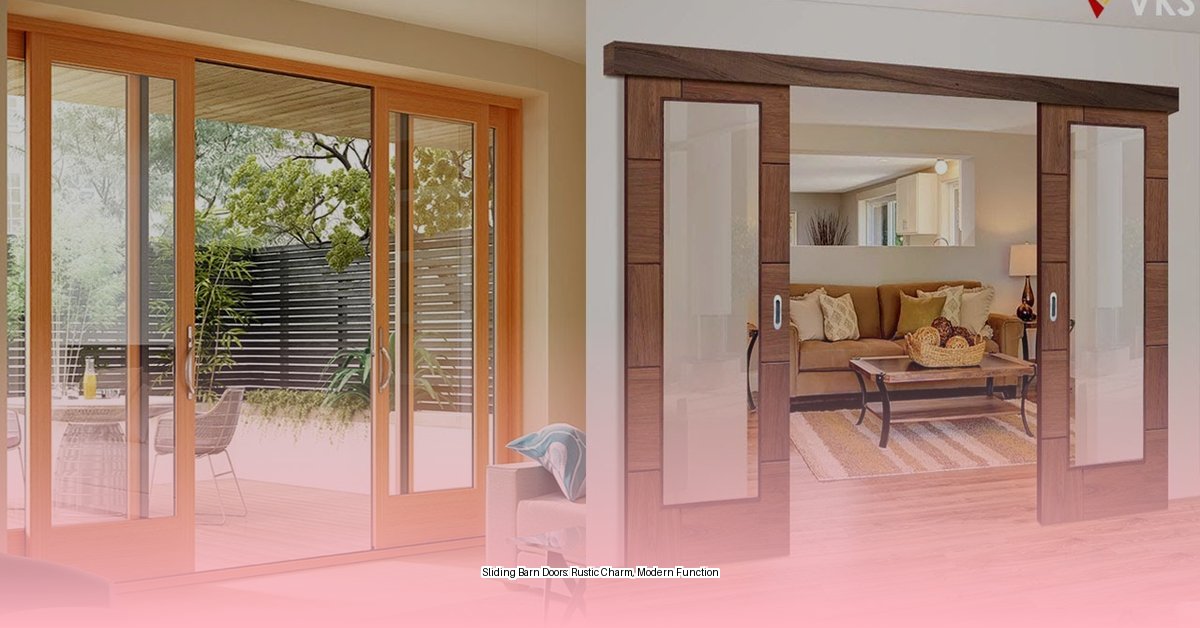Wooden sliding doors offer more than just functionality; they infuse a space with character and practicality. This comprehensive guide explores everything from selecting the perfect style and wood species to installation and maintenance, empowering you to transform your home with this versatile design element.
Sliding Door Styles: Finding the Perfect Fit
Sliding doors come in a variety of styles, each offering a unique aesthetic and functional purpose. Understanding these distinctions is crucial for selecting the ideal door for your needs.
-
Barn Doors: Known for their rustic charm and exposed hardware, barn doors add a touch of farmhouse elegance. They’re relatively easy to install but require ample wall space beside the doorway. Sound insulation may be less effective with this style.
-
Bypass Doors: A practical solution for closets and pantries, bypass doors slide along parallel tracks, optimizing space utilization. While cost-effective, they may not provide a complete seal and could produce some noise.
-
Pocket Doors: Disappearing seamlessly into the wall, pocket doors maximize floor space and create a streamlined look. However, installation is more complex, requiring wall framing.
-
Shoji Screens: Originating in Japan, these sliding doors feature translucent panels, often made of rice paper or synthetic alternatives. They offer privacy while allowing soft, diffused light to filter through, creating a serene atmosphere. However, they are not ideal for soundproofing.
-
Sliding French Doors: Adapting the classic French door design, these sliding variations offer timeless elegance and can be customized with glass panels. They provide an airy feel but require adequate space when open.
| Door Style | Description | Pros | Cons |
|---|---|---|---|
| Barn Door | Rustic, exposed hardware | Stylish, easy installation | Requires wall space, limited sound insulation |
| Bypass Door | Two or more doors on parallel tracks | Space-saving, cost-effective | Can be noisy, partial access |
| Pocket Door | Slides into a wall cavity | Maximizes floor space, sleek appearance | Complex installation, requires wall framing |
| Shoji Screen | Translucent panels, often used as room dividers | Privacy while allowing light transmission, creates a calming ambiance | Not ideal for soundproofing |
| French Doors (Sliding) | Hinged doors adapted to slide | Classic style, customizable with glass panels, elegant | Requires ample space when open |
Current research suggests that homeowners are increasingly prioritizing flexible, multi-functional spaces. Sliding doors, with their adaptability and space-saving design, align perfectly with this trend.
Wood Species: Balancing Beauty and Durability
The choice of wood species significantly impacts the door’s appearance, durability, and cost. Each wood type possesses unique characteristics, influencing its suitability for various applications.
-
Softwoods:
- Pine: A budget-friendly and readily available option, pine is easy to work with and accepts paint and stain well. However, it’s less durable than hardwoods and prone to dents.
- Cedar: Naturally weather-resistant, cedar is a suitable choice for exterior sliding doors. It offers a pleasant aroma and reddish-brown hue but is typically more expensive than pine. Might not be as suitable for interior high-humidity areas like the bathroom.
-
Hardwoods:
- Alder: A popular choice for its warm tones, attractive grain, and ability to readily accept stains. It offers good durability at a mid-range price point.
- Poplar: A cost-effective hardwood option known for its smooth surface and paintability. However, its grain might be less visually appealing compared to other hardwoods.
- Maple: Renowned for its strength, smooth finish, and resistance to scratches. It’s a versatile choice suitable for modern interiors and comes at a mid-range price.
- Oak: A classic hardwood known for its distinctive grain patterns, warm tones, and excellent durability. It’s a robust choice but comes at a premium price.
- Mahogany: A luxurious hardwood with rich, reddish-brown tones and excellent rot resistance. It adds a touch of elegance but falls on the higher end of the price spectrum. Some sustainably forested species of Mahogany can cost less.
- Fir: Offers a balance of strength, stability, and affordability with a straight grain and light color.
-
Reclaimed Wood: An environmentally friendly option that adds unique character and history to your home. The specific species and its properties will vary depending on the source of the reclaimed wood.
| Wood Species | Durability | Cost | Appearance | Sustainability | Workability |
|---|---|---|---|---|---|
| Pine | Moderate | Low | Light color, noticeable grain | High | Easy |
| Cedar | High (Exterior) | Medium | Reddish-brown, aromatic | Medium | Easy |
| Alder | Medium-High | Medium-High | Warm tones, attractive grain | Medium-High | Medium |
| Poplar | Medium | Medium-Low | Smooth, consistent grain | High | Easy |
| Maple | High | Medium-High | Fine, uniform grain | Medium-High | Medium |
| Oak | High | High | Distinctive grain, open pores | Medium | Medium-Hard |
| Mahogany | High | High | Rich reddish-brown, fine grain | Low (unless sustainably harvested) | Medium-Hard |
| Fir | High | Medium | Straight grain, light color | High | Medium |
| Reclaimed | Varies | Varies | Varies, often with unique character | Very High | Varies |
Consider the weight of the wood when choosing a species, as heavier doors require more robust hardware. Also, factor in the door’s location. Exterior doors necessitate weather-resistant wood like cedar, while interior doors offer more flexibility. The wood’s natural grain and color play a vital role in the final aesthetic, further influenced by the chosen finish.
Installation: A Step-by-Step Guide
Installing a sliding door can be a rewarding DIY project with careful planning and execution. However, heavier doors and complex installations like pocket doors may benefit from professional assistance. Always consult local building codes before starting your project.
1. Preparation:
- Choose Your Style: Determine the sliding door style (barn, bypass, pocket, etc.) based on your needs and aesthetic preferences.
- Select Your Wood: Consider the factors discussed earlier, balancing aesthetics, durability, cost, and weight.
- Gather Tools and Materials: Assemble the necessary tools, including a drill, screws, level, measuring tape, safety glasses, and the chosen hardware kit.
2. Hardware and Opening Preparation:
- Select Hardware: Choose hardware rated for the door’s weight and compatible with the chosen sliding system. Heavier doors require more robust tracks and rollers.
- Prepare the Opening: Measure the door opening accurately. Install a sturdy header board above the opening, especially for heavier doors, to provide solid support for the track.
3. Track Installation:
- Mount the Track: Securely attach the track to the header board or directly to the wall, ensuring it is perfectly level. Use appropriate fasteners for your wall type. Different mounting methods exist; research the best approach for your specific situation.
4. Door Installation and Adjustments:
- Attach Hangers: Mount the hangers to the door according to the manufacturer’s instructions.
- Hang the Door: Carefully lift and hang the door onto the rollers in the track.
- Adjust and Test: Ensure the door glides smoothly and effortlessly along the track. Adjust the rollers as needed.
5. Final Touches:
- Install Guides and Stops: These components prevent the door from swaying and ensure secure closure.
- Install Hardware: Attach handles, pulls, and any other decorative elements.
Troubleshooting:
- Sticking Door: Clean the tracks and lubricate them with silicone-based spray. Check for and replace worn rollers.
- Uneven Movement: Ensure the track is perfectly level. Use shims if necessary to correct any unevenness in the wall or header board.
Maintenance: Preserving Beauty and Functionality
Regular maintenance is essential for prolonging the life and smooth operation of your sliding door.
-
Track Cleaning: Regularly clean the tracks to remove dust, debris, and dirt buildup. Use a vacuum, brush, and mild soap and water solution. Avoid lubricating aluminum tracks.
-
Lubrication: Lubricate the rollers and tracks (except aluminum) periodically with silicone-based spray. This reduces friction and prevents sticking.
-
Weatherstripping (if applicable): Inspect and replace worn weatherstripping to maintain a good seal, preventing drafts and energy loss.
-
Roller Care: Clean the rollers regularly and lubricate if they are not sealed. Ensure proper alignment for smooth operation. Replace worn or damaged rollers.
-
Wood Care: Clean the door regularly with a damp cloth and mild cleaning solution. Refinish periodically to protect the wood from moisture and damage.
-
Hardware Maintenance: Inspect and tighten loose screws on handles, locks, and other hardware components. Replace damaged hardware promptly.
By following these maintenance tips, you can ensure your wooden sliding door continues to operate smoothly and enhance your home’s beauty for years to come. Remember, ongoing research continually explores new materials and techniques for sliding door maintenance, so staying informed about the latest advancements is beneficial.
- How to Get Mustard Out of Clothes: A Complete Guide - April 26, 2025
- How to Get Motor Oil Out of Clothes: Proven Methods & Step-by-Step Guide - April 25, 2025
- How to Get Mothball Smell Out of Clothes: A Complete Guide - April 25, 2025










